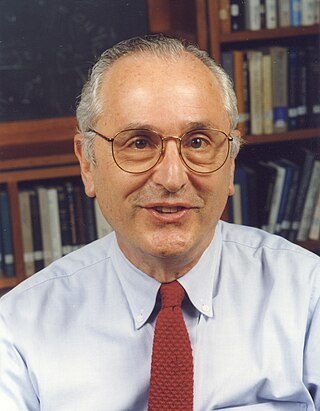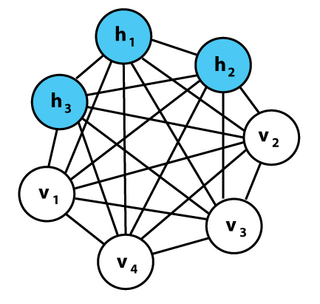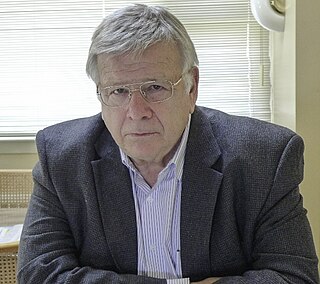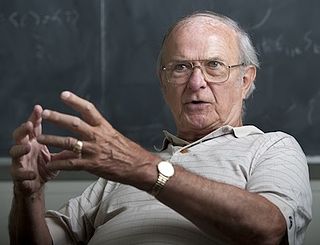
Kip Stephen Thorne is an American theoretical physicist and writer known for his contributions in gravitational physics and astrophysics. Along with Rainer Weiss and Barry C. Barish, he was awarded the 2017 Nobel Prize in Physics for his contributions to the LIGO detector and the observation of gravitational waves.

Leon N. Cooper was an American physicist and professor of Brown University. His name is associated with his work on superconductivity and neuroscience. He proposed the Cooper pair mechanism in 1956 and in 1972 he was awarded the Nobel Prize in Physics with John Bardeen and John Robert Schrieffer for the development of the BCS theory of superconductivity.

Geoffrey Everest Hinton is a British-Canadian computer scientist, cognitive scientist, cognitive psychologist, known for his work on artificial neural networks which earned him the title as the "Godfather of AI".

John Norris Bahcall was an American astrophysicist and the Richard Black Professor for Astrophysics at the Institute for Advanced Study. He was known for a wide range of contributions to solar, galactic and extragalactic astrophysics, including the solar neutrino problem, the development of the Hubble Space Telescope and for his leadership and development of the Institute for Advanced Study in Princeton.

Phillip James Edwin Peebles is a Canadian-American astrophysicist, astronomer, and theoretical cosmologist who was Albert Einstein Professor in Science, emeritus, at Princeton University. He is widely regarded as one of the world's leading theoretical cosmologists in the period since 1970, with major theoretical contributions to primordial nucleosynthesis, dark matter, the cosmic microwave background, and structure formation.

A Boltzmann machine, named after Ludwig Boltzmann is a spin-glass model with an external field, i.e., a Sherrington–Kirkpatrick model, that is a stochastic Ising model. It is a statistical physics technique applied in the context of cognitive science. It is also classified as a Markov random field.
A Hopfield network is a form of recurrent neural network, or a spin glass system, that can serve as a content-addressable memory. The Hopfield network, named for John Hopfield, consists of a single layer of neurons, where each neuron is connected to every other neuron except itself. These connections are bidirectional and symmetric, meaning the weight of the connection from neuron i to neuron j is the same as the weight from neuron j to neuron i. Patterns are associatively recalled by fixing certain inputs, and dynamically evolve the network to minimize an energy function, towards local energy minimum states that correspond to stored patterns. Patterns are associatively learned by a Hebbian learning algorithm.
Terrence Joseph Sejnowski is the Francis Crick Professor at the Salk Institute for Biological Studies where he directs the Computational Neurobiology Laboratory and is the director of the Crick-Jacobs center for theoretical and computational biology. He has performed pioneering research in neural networks and computational neuroscience.

Ronald William Prest Drever was a Scottish experimental physicist. He was a professor emeritus at the California Institute of Technology, co-founded the LIGO project, and was a co-inventor of the Pound–Drever–Hall technique for laser stabilisation, as well as the Hughes–Drever experiment. This work was instrumental in the first detection of gravitational waves in September 2015.

Gerald Stanford "Gerry" Guralnik was the Chancellor’s Professor of Physics at Brown University. In 1964, he co-discovered the Higgs mechanism and Higgs boson with C. R. Hagen and Tom Kibble (GHK). As part of Physical Review Letters' 50th anniversary celebration, the journal recognized this discovery as one of the milestone papers in PRL history. While widely considered to have authored the most complete of the early papers on the Higgs theory, GHK were controversially not included in the 2013 Nobel Prize in Physics.
The Boltzmann Medal is a prize awarded to physicists that obtain new results concerning statistical mechanics; it is named after the celebrated physicist Ludwig Boltzmann. The Boltzmann Medal is awarded once every three years by the Commission on Statistical Physics of the International Union of Pure and Applied Physics, during the STATPHYS conference.
The Canadian Institute for Advanced Research (CIFAR) is a Canadian-based global research organization that brings together teams of top researchers from around the world to address important and complex questions. It was founded in 1982 and is supported by individuals, foundations and corporations, as well as funding from the Government of Canada and the provinces of Alberta and Quebec.

Syukuro "Suki" Manabe is a Japanese–American physicist, meteorologist, and climatologist, who pioneered the use of computers to simulate global climate change and natural climate variations. He was awarded the 2021 Nobel Prize in Physics jointly with Klaus Hasselmann and Giorgio Parisi, for his contributions to the physical modeling of Earth's climate, quantifying its variability, and predictions of climate change.

Carl Richard Hagen is a professor of particle physics at the University of Rochester. He is most noted for his contributions to the Standard Model and Symmetry breaking as well as the 1964 co-discovery of the Higgs mechanism and Higgs boson with Gerald Guralnik and Tom Kibble (GHK). As part of Physical Review Letters 50th anniversary celebration, the journal recognized this discovery as one of the milestone papers in PRL history. While widely considered to have authored the most complete of the early papers on the Higgs theory, GHK were controversially not included in the 2013 Nobel Prize in Physics.

William Henry Press is an astrophysicist, theoretical physicist, computer scientist, and computational biologist. He is a member of the U.S. National Academy of Sciences, the American Academy of Arts and Sciences, and the Council on Foreign Relations. In 1989, he was elected a Fellow of the American Physical Society "in recognition of important theoretical contributions to relativistic astrophysics and to cosmology" Other honors include the 1981 Helen B. Warner Prize for Astronomy. Press has been a member of the JASON defense advisory group since 1977 and is a past chair.
Hugh David Politzer is an American theoretical physicist and the Richard Chace Tolman Professor of Theoretical Physics at the California Institute of Technology. He shared the 2004 Nobel Prize in Physics with David Gross and Frank Wilczek for their discovery of asymptotic freedom in quantum chromodynamics.
The Computation and Neural Systems (CNS) program was established at the California Institute of Technology in 1986 with the goal of training PhD students interested in exploring the relationship between the structure of neuron-like circuits/networks and the computations performed in such systems, whether natural or synthetic. The program was designed to foster the exchange of ideas and collaboration among engineers, neuroscientists, and theoreticians.
John Joseph Hopfield was a Polish-American physicist. Hopfield's published research included vacuum ultraviolet spectroscopy and solar ultraviolet spectroscopy. He was the discoverer of the "Hopfield bands" of oxygen and co-discoverer of the "Lyman–Birge–Hopfield bands" of nitrogen. For about a decade he was an industrial physicist working with technologies for fabricating glass windows, and was the inventor listed on several related patents.
James P. Eisenstein is an American physicist noted for his experimental research on strongly interacting two-dimensional electron systems. He is currently the Frank J. Roshek Professor of Physics and Applied Physics, Emeritus, at the California Institute of Technology.

John Michael Jumper is an American chemist and computer scientist. He currently serves as director at Google DeepMind. Jumper and his colleagues created AlphaFold, an artificial intelligence (AI) model to predict protein structures from their amino acid sequence with high accuracy. Jumper stated that the AlphaFold team plans to release 100 million protein structures.














